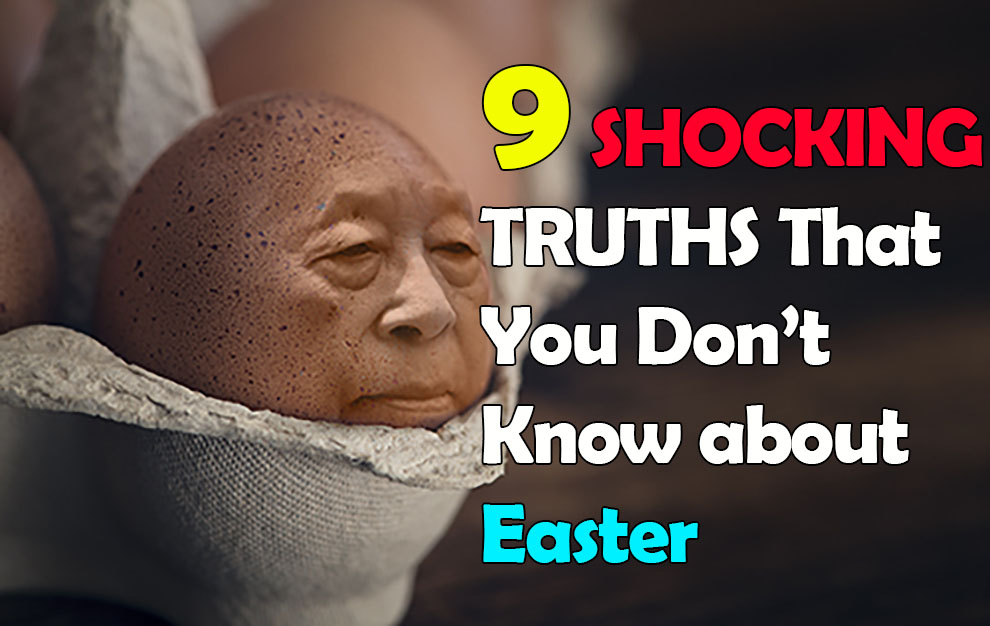Have you heard of these 9 truths about Pagan Easter?
Christians know that Easter commemorates the death and resurrection of Jesus Christ on Easter Sunday. But have you ever wondered why it is called Easter? And how does the Easter bunny or even painted eggs come into the picture of Christ's resurrection?
I did some research.
Fact#1 - Do You Know that the name Easter was derived from a pagan goddess?
Yes! It's true! It all began with people living in the northern hemisphere.

The Germanic people up north celebrated the coming of Spring (in
March /April) and worshiped Ostara, goddess of fertility and renewal of life. Ostara is also known as Eostera, the goddess of Dawn or Light ;and is loosely related to the Germanic word for "east" and "glory'.
On the left, you see an early depiction of the pagan goddess Eostera in 1884. She is one with nature and ushers in Spring
In their efforts to make Christianity more palatable for the natives and gain more converts, the early churches embedded Christian messages and beliefs into pagan customs and festivities of the indigenous people.
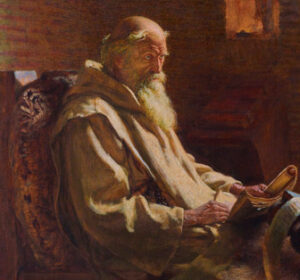
In the 8th century, a highly regarded Anglo-Saxon monk Bede wrote De Temporum ratione (Reckoning of Times), describing the conversion of Anglo-Saxon tribes to Christianity and the pagan customs and traditions at that time. He recounted that the Eostre celebration was slowly being replaced by the Paschal month (Passover) or the Christian celebration of the resurrection of Jesus.
Since both Eostre and Paschal month celebrations occur in the month of April or in Old English - "Eosturmononath" meaning "month of Eostre", the church slowly adopted the name "Easter" from their pagan Eostre celebration, to mark Jesus' resurrection.
The Resurrection of Jesus was originally known as Pascha (in Aramaic) or Pesach (in Hebrew) which referred to the Jewish Passover.
What is the link between Easter and the Jewish Passover?
In English speaking countries, we call this day, Easter.
How do you pronounce Eostre?
Is Eostre being worshiped or celebrated today?
Yes! Even to this day, there are still people who worship and celebrate Eostre or Ostara at the start of spring. Ostara is a Wiccan holiday with many traditions similar to Easter.. Hence Pagan Easter.
Fact#2 - Do you know that Easter falls on the First Sunday of every Spring (Vernal) Equinox?
What is an Equinox?
An Equinox is the instance during a yearly cycle when the sun is directly above the equator. During this time, everyone earth, both the north and south, receives equal number of day and night hours.
There are two equinoxes in a year, namely;
- March equinox - also known as Spring/Vernal equinox
- September equinox - also known as autumnal equinox
In 325AD, the Council of Nicaea decreed to celebrate Christ's resurrection on the first Sunday following the first full moon after the Spring (Vernal) equinox. Hence the date of Easter will fall between 25 March to 22 April.
Do you want to know the Easter Dates for the next 99 years.
Who comprised the Council of Nicaea in 325AD?
If you have watched the movie "The Da Vinci Code '' starring Tom Hanks, you would have heard about the Council of Nicaea being an important part of the fictitious story.
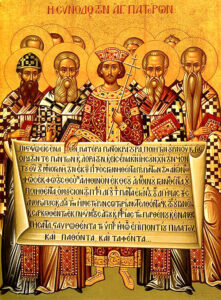
But who attended the Council of Nicaea?
The First Council of Niceaea was presided by Bishop Hosius of Corduba (Spain) and the Roman Emperor Constantinople, with about 318 other religious leaders in attendance.
The purpose of the council was to deliberate on matters regarding Christendom and restore peace through consensus in their practices.
Above is an early depiction of Emperor Constantine and the bishops of the First Council of Nicaea (325) holding the Niceno-Constantinopolitan Creed of 381
Fact#3 - Do You Know that Easter Eggs were used to Tell the Story of New Life and the Resurrection?
Many religions and beliefs have always used eggs to symbolize new life and new beginnings. But a broken egg tells a different story.

Early missionaries not only used eggs to illustrate new beginnings for new Christian believers, they also used the broken egg shells to represent the empty tomb found on Easter Sunday.
The broken egg shell/tomb was found empty because Christ has risen. The chick that comes out from the egg represents Christ and the egg shell, the empty tomb.
And with this miracle of Christ's resurrection, Christians all over the world believe that they will, one day, also resurrect and be with Jesus for eternity.
Fact#4 - Do You Know that Painting Easter Eggs started with the Persians and the Early Churches?

Ancient Persia (now Iran) had the tradition of painting and decorating their eggs to usher in the Persian New Year, Nowruz which falls on the Spring equinox.
This might possibly explain why early Mesopotamian Christians dyed their eggs red when they celebrated Easter. This practice was later adopted by the early church in 1610.
In the middle ages, the early Christians in Europe would fast during the month (season of Lent) before Good Friday. Devout believers would pray and abstain from dairy products like cheese and eggs to prepare themselves for Easter.

Eggs harvested during the season of Lent could not be consumed but were hard-boiled in order to preserve them.
Over time, families began painting and decorating their hard boiled eggs during Lent and eating them only on Easter Sunday; when the period of fasting had officially ended.
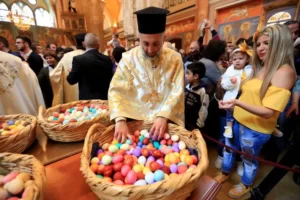
In 1610, under Pope Paul V, the Catholic Church adopted the custom of using eggs as a symbol of new life to represent the resurrection of Jesus .
They also started painting the eggs red to signify the blood of Christ shed on the cross.
Fact#5 -Do You Know that the Easter Bunny was a Symbol of Fertility?

In the celebration of Eoster (Ostrar), the Easter rabbit or "Osterhase", was used as a symbol of fertility and abundance even till today. Spring was the mating season for rabbits at that time and rabbits reproduce prolifically.
Rabbits can reproduce as many as seven litters per year, with an average of about four to five rabbits per litter to a maximum of twelve per liter!
The world's largest number of rabbits produced was 24 rabbits per litter by two New Zealand rabbits.
Easter Bunny Eggs?

According to legend, the Easter bunny was said to be able to lay beautiful eggs.
Legend says that the goddess Ostrar/Eostre found a bird with wings that were frozen and could not fly. Showing mercy, Ostrar transformed the bird into a hare to keep it warm.
In gratitude, the hare laid beautiful eggs for Ostrar. Hence the birth of the egg-laying Easter bunny "Osterhase".
Do you know that the festival of the goddess Ostrar/Eostre is still celebrated today?
Wiccans (witches) today still celebrate the festival of Ostara (Eostre) with traditions that are similar to Easter! The hare was deemed a sacred animal to Ostrar.
Fact#6 - Do You Know that a German Duchess may have started the Easter Bunny story?

Legend has it that a German Duchess, Rosalinda von Lindenberg and her family escaped from home because of war, and took refuge in a remote village.
In repayment for the kindness shown by the villages, the duchess planned a special treat for their children. On the eve of Easter, Roslinda collected many chicken eggs and coloured them by boiling them with leaves, flowers and roots.
On Easter morning, Roslinda gathered the village children and taught them how to build nests in the woods using sticks and moss.
While the children were having their Easter lunch, Roslinda secretly placed the coloured eggs in the nests for the children to find.
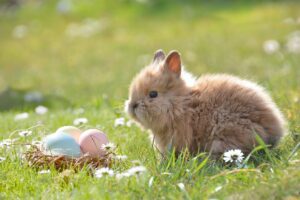
The children were thrilled and amazed when they discovered colourful eggs in their nests that they had built earlier.
Since they did not see any chickens but only rabbits hopping around their nests, the children quickly assumed that the rabbits were the ones who laid the colourful eggs.
Hence the birth of the Easter bunny and egg tradition.
Fact#7 - Do You Know that You Can Track the Easter bunny as he circles around the Globe during Easter?

According to legend, the Easter Bunny lives on Easter Island and starts his journey from Christmas Island at 5am ET on the eve of Easter.
He travels around the globe, delivering baskets of treats/ candies/ coloured eggs/ toys to all the kids in the world within 24 hours and ends his journey at the American Samoa.
You can track the Easter Bunny at https://trackeasterbunny.com/easter-bunny-tracker
The app allows your child to track the following :
- the last location visited by the Easter bunny every hour
- the speed of the easter bunny
- the number of deliveries the Easter bunny has made
- the number of carrots that the Easter Bunny has eaten
Check it out with your kid.. they will be ecstatic!
Fact#8 - Do You Know that the Easter Bunny was named Peter?

Many thought that the Easter Bunny was a female since it lays eggs.
But my research found something interesting..
The Easter Bunny is a fictitious magical creature wearing a white coat with long ears.
The first story book about the Easter Bunny ever published was "The Easter Bunny Who Overslept", written by Priscilla and Otto Friedrich in 1957.
It's a wonderful book for you to read to your kids.
You may watch the read-aloud video below.
But it was the song "Here comes Peter Cottontail by Steven Nelson and Jack Rollins in 1949 that confirmed the name of the Easter Bunny as Peter Cottontail.
Ha! So the Easter Bunny is indeed a BOY!!
Enjoy the song!
Fact#9 - Do You Know that Easter was never mentioned in the Bible?

There is no instruction in the Bible for Christians to celebrate Easter or the resurrection of Jesus. The only instruction that Christ wanted us to follow, that was related to his death and resurrection, was the last supper.
Jesus broke bread and drank wine, asking his disciples to "do this in remembrance of me"
"And he took bread, and gave thanks, and brake it, and gave unto them, saying, This is my body which is given for you - do this in remembrance of me."
NKJV Luke 22:19
Let me know if you can find a phrase from the Bible that instructs Christians to celebrate Easter.. so if it was never in the Bible, then why do Christians celebrate Easter?
Should Christians celebrate Easter? Is Easter a Pagan Holiday?
Let me know in the comments below.
Happy Easter!!

